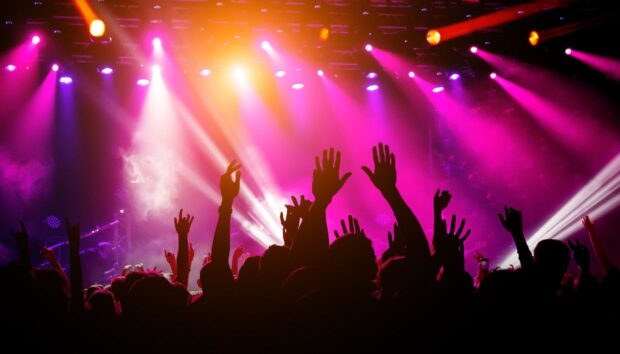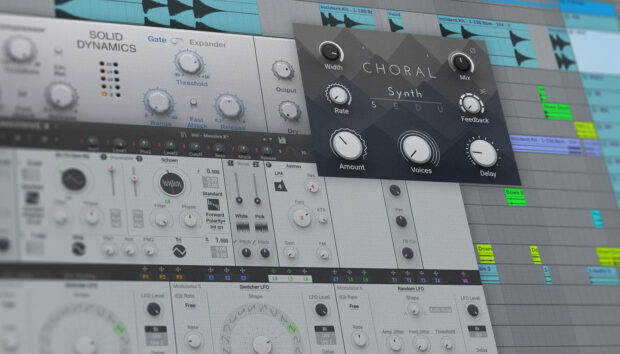
Multi-instrumentalist Nandi Rose Plunkett’s heads up the Brooklyn-based outfit Half Waif. Following several EPs, their forthcoming album ‘Lavender’ revels in Celtic melodies and discordant electronic soundscapes, using MASSIVE as its creative hub.
“She came out singing!” proclaimed the parents of Nandi Rose Plunkett – the daughter of an Indian refugee and American father of Irish/Swiss descent. Influenced by her dad’s love of Celtic folk and the textured electronic musings of Radiohead and Björk, Plunkett’s synth-pop project Half Waif is a unique menagerie of syncopated beats and programming with ephemeral folk undertones.
Having long sought self-expression, Plunkett now balances her career as a creative pivot, navigating her way through a male-dominated industry. Half Waif’s debut album Lavender, released this April, is a hypnotic mix of electroacoustic elements. Gritty yet graceful, abrasive-sounding yet alluring, Plunkett’s electronic soundscapes – driven by MASSIVE, act as the driving force for her raw, introspective lyricism.
Exploring her inner world
I grew up in Williamstown, Western Massachusetts. It’s a small, isolated place and a very rural environment. As a kid, I would spend a lot of time playing outside in the yard in my own little corner of the world, surrounded by nature. There was theatre, arts and culture, but no venues or music scene, so music felt like a really private and isolated thing for me.
I spent a lot of time writing songs in my living room on the piano. It began as a very private and personal journey. The music’s pretty stormy, moody, textural and grandiose, but the subject matter is much more contemplative, coming from this place of loneliness and identity seeking. I like the idea of the lyrics exploring this quieter impetus while the music itself explodes with all the possibilities of my inner world.
The folk influence
The folk-influence comes from my dad. He has an Irish background and is really into Celtic folk. He plays a lot of Celtic instruments like the bodhrán, cittern and the concertina; we still have a lot instruments lying around the house. It wasn’t consciously absorbed. In fact, I never set out to write any kind of music, which has created a puzzle for me because I don’t know what music I write. I understand the human tendency to put labels on things, but I have no idea how to explain Half Waif because there are all these disparate elements of classical music, vocals, lyrics and electronic programming.
Finding electronic music
When I was growing up, electronic music was not accessible to me or part of my musical language. I was very inspired by show tunes and did a lot of musical theatre as a kid, which is so nerdy [laughs]. In my sophomore year, I went to college and took a computer music class about the history of electronic music. It included the history of synthesizers, synthesis and computer language programming, and I got to use Pro Tools and Logic.
Having that free software gave me the tools to make music – minimally at first, but I’ve always been interested in melding electronic and acoustic sounds. I really got into Radiohead in high school and remember thinking, what are these mind blowing sounds embedded into the songs and melodies? It was the same when I first started listening to Björk. Both are amazing songwriters that really push the boundaries with their sonic language.

Embracing her band mates
Zack [Levine] is my partner and Adan Carlo is one of my best friends. They’re two people I trust deeply and we’ve been playing together for five years in various iterations. The record we’ve just finished, Lavender, was the most collaborative I’ve done. I’m the full songwriter, but Zac kand Adan have been amazing in bringing their skills on bass and drums and coming up with live arrangements.

For the new record, we were living together during the summer and did more of the production together. It was the first time that I’ve worked on a record with a band, which was scary for me. I don’t know if it’s because I’m a woman, but I usually want to do everything myself to prove that I can. But the fact of the matter is, I can’t have skills in every area and I’ve recognised that it’s okay to ask for help.
Studio setup
My studio setup’s pretty simple. I write demos using software and when I want to work on the song more intensely I’ll replace those sounds, either with better software or my Korg Monologue and Minilogue analogue synths. I used to use Logic but was given Ableton when I did some collaborative non-profit recording projects and became much faster at using it.
I also have a bunch of Ableton Packs, but I’m really excited by the MASSIVE synth because it’s one of the only software synths I’ve got. I’ve had it since the beginning of my software journey and use it all the time.
If I’m working on a song and want a saw tooth, a pad, or a short delay or release sound, I know I can turn to MASSIVE.
I first discovered MASSIVE in around 2011. I just love its huge array of sounds, which are really like ‘massive’, but having a synth that has a lot of character and a big sound is a real go-to aspect for me. The interface itself is really clear, straightforward and fun to use and gives me the ability to manipulate, affect parameters and easily exchange different waveforms. When I started to learn how synths worked, it just made a lot of sense to see a synth laid out the way that MASSIVE is. Getting to play around with the different parameters and hear all the changes feels very intuitive, which was especially important when I first starting out using soft synths. I’ve never been intimidated by it, because it’s such an easy and friendly synth to use and tweak for whatever I need.
When I first got MASSIVE, I loved the fact that it was not a steep learning curve. For me, it was very easy to delve into. One of the reasons I haven’t branched out into using other software programs is because MASSIVE’s not only easy to use, but you can manipulate its sounds endlessly. Because there’s such a huge bank of presets that you can change and manipulate in countless ways, I’ve never got tired of using it.
I’ve also got better at recognising what I need from using MASSIVE. If I’m working on a song and want a saw tooth, a pad, or a short delay or release sound, I know I can turn to MASSIVE. That’s been really helpful in terms of finding the types of sounds that I want to use as a producer and arranger, because I can always easily find a sound within the presets that is similar to whatever I’m imagining in my head.
Textured pads
I definitely notice that when I’m scrolling through MASSIVE’s sound banks, there’s this array of huge bass sounds, but since I tend to use the Korg Monologue for synth bass, MASSIVE is more about filling the sound with big pads. I’m usually looking for something that’s very characteristic, not just an ethereal pad – I can get that another way, but a sound that has motion and texture built into it. I use MASSIVE’s synth pads a lot when I’m looking for a sound that will feel really unique inside a song.
MASCHINE: From live to studio
A couple of years ago, Adan used MASCHINE in an iteration of our live show. Zack was solely playing an acoustic drum kit and Adan would be on MASCHINE with another friend on synth bass and trumpet. Then we started using MASCHINE and its corresponding software to help select some of our drum sounds when we started working on the new record.
It was cool to be able to scroll through a million kicks and snares. We really took our time selecting each sound because we wanted to be a lot more specific and careful in terms of the drum sounds and programming on this record. When I was working alone I’d maybe be too lazy to go into the minutiae of each sound, but Zack and Adan contribute a lot more to that side of things now.
New live setup
Right now, Zack is using the Roland SPD-SX for all the electronic and acoustic percussion and Adan is back to playing bass again. He has a ton of really cool pedals that emulate synths sounds, so he’s using the bass in a really interesting and unique way.



Zack’s got his mix of sounds and I have two keyboards that I play live and a vocal processing pedal. We might have to do a more electronic set for the new record, but we come from a background of playing instruments and want to bring acoustics into a live setting to show that and create something exciting for people to watch.















